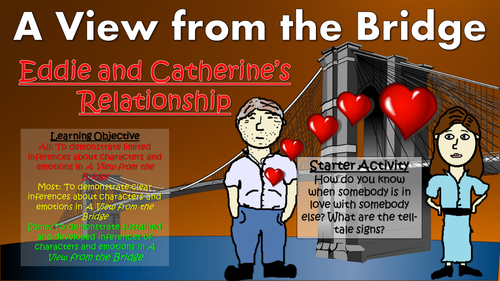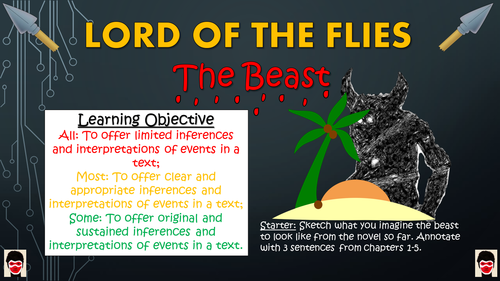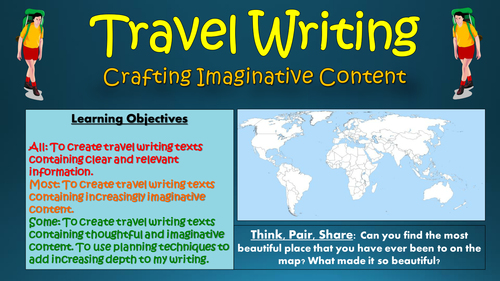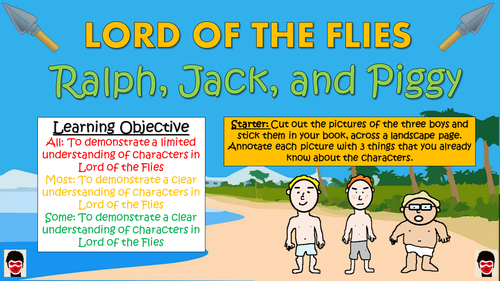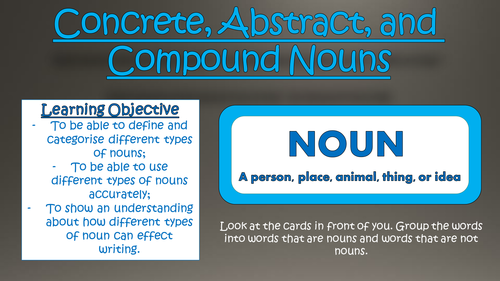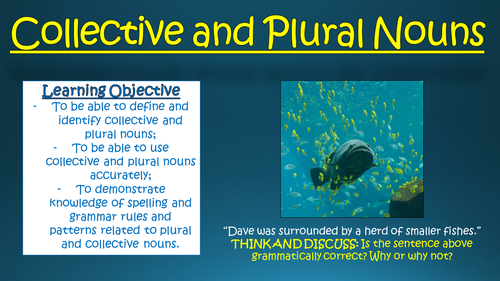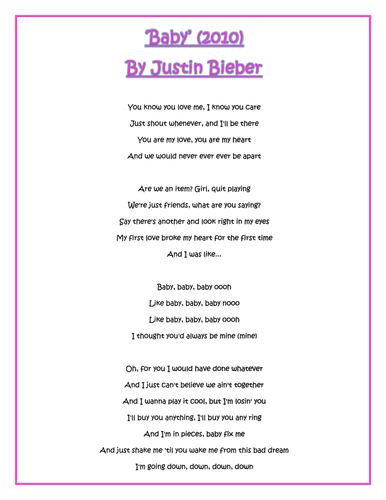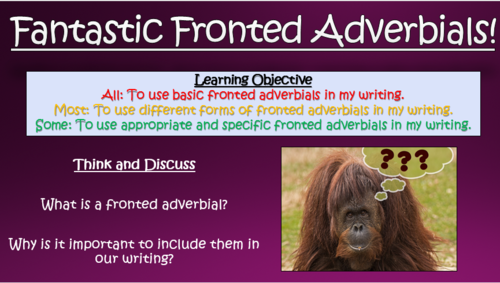
3k+Uploads
1910k+Views
2242k+Downloads
Languages

A View from the Bridge: Eddie and Catherine's Relationship
This interesting and highly-stimulating enables students to make clear and sustained inferences regarding the main characters and their relationships in Arthur Miller’s A View from the Bridge. In particular, students read between the lines in decoding the subtle cues suggestive of Eddie’s feelings towards Catherine in the opening stages of Act I.
The lesson follows a clear, logical, bite-size learning journey, which guides students towards differentiated learning objectives. Over the course of this journey, they become able to:
- Understand the key learning skill of inference;
-Infer key meanings from short extracts of texts;
- Read and understand the opening section of Act I, in which we are introduced to the Carbone family, and infer and interpret the key information provided regarding their relationships;
- Demonstrate an understanding of Eddie's hidden feelings for Catherine, and Beatrice's knowledge of this;
- Write an emotive diary entry from Beatrice's viewpoint, using evidence from the text to demonstrate an understanding the key meanings from the act;
-Peer assess each other's learning attempts.
This resource pack includes:
- A visually engaging whole-lesson PowerPoint presentation;;
- Paper copies and online links to the extract needed for the lesson (Beginning of Act I);
- Inferences worksheet (including answer sheet for teachers);
- A detailed lesson plan, complete with what the teacher and students should aim to achieve at each stage of the lesson.
All images are licensed for commercial use, and are cited on the final slide of the PowerPoint.

Similes and Metaphors in Popular Music!
This interesting and highly stimulating lesson enables students to demonstrate a developed and sustained understanding of the effect of figurative language in popular music texts. In particular, students learn to explore the meanings behind similes and metaphors across songs from a range of genres, considering the effect upon the whole text and the intended audience. As one would expect, Students love learning about similes and metaphors through popular music, and this lesson can really help to open students' eyes to how language can be crafted for effect. This has numerous benefits in later poetry and descriptive writing lessons.
The lesson follows a clear, logical, bite-size learning journey, which guides students towards differentiated learning objectives. Over the course of this journey, they become able to:
- Define and identify similes and metaphors;
- Explain the similarities and differences between songs and poetry;
- Observe and listen to several examples of similes and metaphors in popular music examples;
- Understand and analyse the effect of similes and metaphors upon meanings and the reader;
- Apply their knowledge of why similes and metaphors are used to a range of contexts and musical genres;
- Collaborate and present their key findings about similes and metaphors in songs to their classmates;
- Self-assess their learning attempts.
This resource pack includes:
- A visually engaging whole-lesson PowerPoint presentation;
- Link to an online compilation video of similes and metaphors in popular music;
- 3 x lyrics analysis worksheets of varying difficulties (Katy Perry, Train, and Florence and the Machine - all clean)
- A detailed lesson plan, complete with what the teacher and students should aim to achieve at each stage of the lesson.
All images are licensed for commercial use, and are cited on the final slide of the PowerPoint.
Bundle Sale

Lord of the Flies Huge Bundle!
This bundle contains all of the Lord of the Flies lessons, the comprehension activities booklet, the knowledge organiser and the Pointless game!
These engaging, varied, and informative lessons have been designed to help students gain a valuable understanding of the plot, characters, language, and key messages in William Golding’s novel ‘Lord of the Flies.’ The lessons enable students to gain a comprehensive understanding of the key features of content, language, and structure, in addition to considering Golding’s key intentions in writing the novel.
All of the resources that you need to teach are included in the bundle: Whole lesson step-by-step PowerPoint presentations, informative and engaging , worksheets, activities, and lesson plans.
Contained in the bundle are lessons based on:
- 1. Savagery vs Civilization;
- 2. Ralph, Jack, and Piggy;
- 3. Golding’s Language Devices;
- 4. The Beast
- 5. Simon and Roger
- 6. The Ending
Plus the 30-page comprehension booklet, the knowledge organiser and the Lord of the Flies Pointless Game!
Stimulating, visual, and easily adaptable, these lessons provide suggested learning objectives and outcomes for students of a wide-range of abilities - The vast majority of tasks are differentiated to allow for different abilities and needs in your classroom. Each lesson loosely follows this logical learning journey to ensure that students learn in bite-size steps:
- Engaging
- Defining/ Understanding
- Identifying/Remembering
- Analysing/ Creating
- Peer or self evaluating.
All of the lessons are interactive, employ a variety of different teaching and learning methods and styles, and are visually-engaging.

Lord of the Flies: The Beast
This interesting and highly-stimulating lesson enables students to make important inferences and interpretations regarding ‘the beast’ that is referred to by the boys on the island throughout William Golding’s novel Lord of the Flies. In particular, students form opinions of what the beast may represent, based upon key evidence throughout the text.
The lesson follows a clear, logical, bite-size learning journey, which guides students towards differentiated learning objectives. Over the course of this journey, they become able to:
- Establish, sketch, evidence, and share their initial interpretations of the beast;
- Collaborate with others to form rational and substantiated opinions;
- Read and understand Chapters Six and Seven of the play, with a particular focus upon how Golding utilises the beast to depict other concepts and notions;
- Analyse key quotations which refer to the beast in relation to each of the characters;
- Give appropriate and sustained interpretations and inferences regarding altering views towards Golding's use of the beast;
-Peer assess each other's learning attempts.
This resource pack includes:
- A visually engaging whole-lesson PowerPoint presentation;
- Detailed worksheet;
- A scaffolded essay template;
- Links to the extracts of the text needed for the lesson (Chapters Six and Seven in this case);
- A detailed lesson plan, complete with what the teacher and students should aim to achieve at each stage of the lesson.
All images are licensed for commercial use, and are cited on the final slide of the PowerPoint.
Bundle Sale

Travel Writing Big Bundle!
Contains all of the Travel Writing Lessons Travel Brochure Writing!
These engaging and detailed resources have been designed to make the teaching and learning of Travel Writing exciting, interesting, and easily accessible for all children. Throughout each lesson, students consider a different element of their writing (content, language, and structure) in order to produce imaginative and appropriate travel writing texts. Each lesson contains a comprehensive whole lesson PowerPoint, all the resources that you will need, and a lesson plan.
Included are the following lessons:
1. Travel Writing: Crafting Imaginative Content
2. Travel Writing: Constructing Imaginative Language;
3. Travel Writing: Creating Imaginative Structures
4. Travel Brochure Writing
All images are licensed for commercial use, and are cited on the final slide of the PowerPoint/ the bottom of worksheets.

Travel Writing: Crafting Imaginative Content
This thought-provoking and stimulating lesson enables students to create travel writing texts containing thoughtful and imaginative content, utilising planning techniques to add increasing depth to their writing. By the end of the lesson, students are able to understand which features should go into a travel writing piece, and use strategies to enable them to write in appropriate depth for the needs of purpose, audience, and form.
The lesson follows a clear, logical, bite-size learning journey, which guides students towards differentiated learning objectives. Over the course of this journey, they become able to:
- Define what travel writing is, and understand why it is an important and popular genre;
- Think beyond the obvious, noticing and describing subliminal and periphery features, in addition to those which they deem as most important and pressing;
- Consider how stimulus can be described using each of the different senses;
- Use a success criteria to analyse a model travel writing attempt, and to plan their own;
- Self/Peer assess travel writing attempts.
This resource pack includes:
- A visually engaging whole-lesson PowerPoint presentation;
- A clear and logical template to record descriptions during the sensory task;
-A well-structured success criteria/ planning template to aid students' creative attempts;
- A detailed lesson plan, complete with what the teacher and students should aim to achieve at each stage of the lesson.
All images are licensed for commercial use, and are cited on the final slide of the PowerPoint/ the bottom of worksheets.

Lord of the Flies: Golding's Language Devices
This interesting and highly-stimulating lesson enables students to gain a clear understanding of the language choices utilised by William Golding’s throughout Chapters 4 and 5 of Lord of the Flies, with particular reference to the advanced figurative language employed in the descriptive sections of the text. Students also learn to analyse the effects of key language choices, with reference to Golding's key intentions throughout the novel.
The lesson follows a clear, logical, bite-size learning journey, which guides students towards differentiated learning objectives. Over the course of this journey, they become able to:
- Define, identify, and exemplify different types of language devices;
- Explain the effects of different language devices on meanings and different audiences;
- Read and understand Chapters Four and Five of the play, with a particular focus upon how Golding utilises language devices to demonstrate the changing feelings and mindsets of the boys on the island;
- Analyse key quotations which utilise effective descriptive devices;
- Analyse the effectiveness of Golding's language devices;
-Peer assess each other's learning attempts.
This resource pack includes:
- A visually engaging whole-lesson PowerPoint presentation;
- Detailed worksheets, with answer sheets where necessary;
- Links to the extracts of the text needed for the lesson (Chapters Four and Five in this case);
- Card sort cards;
- A detailed lesson plan, complete with what the teacher and students should aim to achieve at each stage of the lesson.
All images are licensed for commercial use, and are cited on the final slide of the PowerPoint.

Lord of the Flies: Ralph, Jack, and Piggy
This interesting and highly-stimulating lesson enables students to gain a clear understanding of how the characters of Ralph, Jack, and Piggy are introduced and developed in William Golding’s Lord of the Flies. Students learn to analyse the characters, with particular reference to the dramatization of the conflict between the characters’ instincts of savagery and civility, and how their psyche alters over time.
The lesson follows a clear, logical, bite-size learning journey, which guides students towards differentiated learning objectives. Over the course of this journey, they become able to:
- Use illustrations to explain what they already know about each of the characters;
- Understand how each of the characters are introduced, and demonstrate an awareness of the role that they play on the island;
- Read and understand Chapters Two and Three of the play, with a particular focus upon how the the characters of Ralph, Jack, and Piggy develop over time;
- Analyse key quotations about/by each of the three main characters, highlighting how their psyche is altering;
- Complete two diary entries from the viewpoint of one of the characters, showing a clear understanding of how the character has developed;
-Peer assess each other's learning attempts.
This resource pack includes:
- A visually engaging whole-lesson PowerPoint presentation;
- Detailed worksheets, with answer sheets where necessary;
- Links to the extracts of the text needed for the lesson (Chapters Two and Three in this case);
- Original images for students to complete their annotations;
- A detailed lesson plan, complete with what the teacher and students should aim to achieve at each stage of the lesson.
All images are licensed for commercial use, and are cited on the final slide of the PowerPoint.
Bundle Sale

SPAG: Nouns Lesson Bundle!
These engaging and detailed resources have been designed to make the learning of different types and uses of nouns (particularly prominent in the new curriculum) easily accessible, engaging and interesting for all children. Throughout each lesson, students learn to improve their skill at using appropriate, concise, and precise nouns, and practice employing them within their own writing compositions. Each lesson contains a comprehensive whole lesson PowerPoint, all the resources that you will need, and a lesson plan.
Within this pack is included:
- Exceptional Expanded Noun Phrases;
- Collective and Plural Nouns;
- Concrete, Abstract, and Compound Nouns
All images are licensed for commercial use, and are cited on the final slide of the PowerPoint/ the bottom of worksheets.

Concrete, Abstract, and Compound Nouns!
This interesting and engaging lesson enables students to be able to define and categorise different types of nouns, to be able to use different types of nouns accurately, and to show an understanding about how different types of noun can affect writing. This knowledge is of particular importance when working through the new National Curriculum.
The lesson follows a clear, logical, bite-size learning journey, which guides students towards differentiated learning objectives. Over the course of this journey, they become able to:
- Define what concrete, abstract, and compound nouns are;
- Identify and categorise different concrete, abstract, and compound nouns;
- Write accurately using a range of concrete, abstract, and compound nouns, to increase the depth and variety of their writing;
- Peer assess each other's learning attempts.
This resource pack includes:
- A visually engaging whole-lesson PowerPoint presentation;
- Word cards for sorting;
- Venn diagram mat for card-sorting activity
- Clear and interesting worksheets to record student responses;
- A detailed lesson plan, complete with what the teacher and students should aim to achieve at each stage of the lesson.
All images are licensed for commercial use, and are cited on the final slide of the PowerPoint/ the bottom of worksheets.

Collective and Plural Nouns!
This interesting and engaging lesson enables students to define and identify collective and plural nouns, to be able to use collective and plural nouns accurately, and to demonstrate knowledge of spelling and grammar rules and patterns related to collective and plural nouns. This knowledge is of particular importance when working through the new National Curriculum.
The lesson follows a clear, logical, bite-size learning journey, which guides students towards differentiated learning objectives. Over the course of this journey, they become able to:
- Define what collective and plural nouns are;
- Research and identify different collective and plural nouns;
- Understand patterns and rules in the use of collective and plural nouns;
- Understand how verb form can alter dependent upon whether a noun is collective or plural;
- Write accurately using collective and plural nouns, including the use of the correct noun-verb agreement.
- Peer assess each other's learning attempts.
This resource pack includes:
- A visually engaging whole-lesson PowerPoint presentation;
- Clear and interesting worksheets to record student responses;
- Answer sheets to check student understanding;
- A detailed lesson plan, complete with what the teacher and students should aim to achieve at each stage of the lesson.
All images are licensed for commercial use, and are cited on the final slide of the PowerPoint/ the bottom of worksheets.
Bundle Sale

AQA Love/ Relationships Poetry Lesson Bundle!
These engaging, varied, and informative lessons have been designed to help students gain a valuable understanding of the content, language, and structure features of a range of Love and Relationships poems from the new AQA poetry anthology:
- Simon Armitage - Mother, Any Distance
- Lord Byron - When We Two Parted
- Carol Ann Duffy - Before You Were Mine
- Percy Bysshe Shelley - Love's Philosophy
- Thomas Hardy - Neutral Tones
In addition to this, the lesson on comparing poems is also included - essential for exam technique!
Students will vital skills in: interpreting the significant meanings poems, understanding the writer's ideas within poems, understanding the social and historical contexts of poems, and analysing features of content, language, and structure.
Stimulating, visual, and easily adaptable, these lessons provide suggested learning objectives and outcomes for students of a wide-range of abilities - The vast majority of tasks are differentiated to allow for different abilities and needs in your classroom. Each lesson loosely follows this logical learning journey to ensure that students learn in bite-size steps:
- Engaging
- Defining/ Understanding
- Identifying/Remembering
- Analysing/ Creating
- Peer or self evaluating.
All of the lessons are interactive, employ a variety of different teaching and learning methods and styles, and are visually-engaging. Resources, worksheets, and lesson plans are all provided.
Bundle Sale

Love and Relationships Poetry Lesson Bundle!
These engaging, varied, and informative lessons have been designed to help students gain a valuable understanding of the content, language, and structure features of a range of Love and Relationships poems. Each of the poems are widely studied, with some being from the Literary Heritage bank, and most being fixtures in examination board anthologies:
- Simon Armitage - Mother, Any Distance
- Lord Byron - When We Two Parted
- Carol Ann Duffy - Before You Were Mine
- James Fenton - In Paris with You
- William Shakespeare - Sonnet 116
In addition to this, the lesson on comparing poems is also included - essential for exam technique!
Students will vital skills in: interpreting the significant meanings poems, understanding the writer's ideas within poems, understanding the social and historical contexts of poems, and analysing features of content, language, and structure.
Stimulating, visual, and easily adaptable, these lessons provide suggested learning objectives and outcomes for students of a wide-range of abilities - The vast majority of tasks are differentiated to allow for different abilities and needs in your classroom. Each lesson loosely follows this logical learning journey to ensure that students learn in bite-size steps:
- Engaging
- Defining/ Understanding
- Identifying/Remembering
- Analysing/ Creating
- Peer or self evaluating.
All of the lessons are interactive, employ a variety of different teaching and learning methods and styles, and are visually-engaging. Resources, worksheets, and lesson plans are all provided.
Individually, these resources would amount to £16, meaning that you can save 69%!
These resources can also be bought individually for £2 each
Bundle Sale

An Inspector Calls Lesson Bundle!
These engaging, varied, and informative lessons have been designed to help students gain a valuable understanding of each of the characters in J.B Priestley’s classic play ‘An Inspector Calls.’ The lessons enable students to gain a comprehensive understanding of the key features of plot, character, context, and language, in addition to considering the key messages being offered by Priestley.
All of the resources that you need are included in the bundle: informative and engaging whole lesson PowerPoints, worksheets, activities, and lesson plans.
Contained in the bundle are lessons based on:
- 1. Arthur Birling;
- 2. Sheila and Gerald;
- 3. Sybil and Eric Birling Double Lesson;
- 4. Inspector Goole (Priestley’s message)
- 5. Priestley’s Dramatic Devices
- 6. The Context of the Play
Stimulating, visual, and easily adaptable, these lessons provide suggested learning objectives and outcomes for students of a wide-range of abilities - The vast majority of tasks are differentiated to allow for different abilities and needs in your classroom. Each lesson loosely follows this logical learning journey to ensure that students learn in bite-size steps:
- Engaging
- Defining/ Understanding
- Identifying/Remembering
- Analysing/ Creating
- Peer or self evaluating.
All of the lessons are interactive, employ a variety of different teaching and learning methods and styles, and are visually-engaging.
Bundle Sale

An Inspector Calls Huge Bundle!
THIS HUGE BUNDLE PACK CONTAINS ALL OF THE 'AN INSPECTOR CALLS LESSONS, IN ADDITION TO THE COMPREHENSION BOOKLET, THE KNOWLEDGE ORGANISER, AND THE POINTLESS GAME!
This engaging, varied, and informative scheme of learning is designed to help students gain a valuable understanding of J.B Priestley’s classic play ‘An Inspector Calls.’ The lessons enable students to gain a comprehensive understanding of the key features of plot, character, context, and language, in addition to considering the key messages being offered by Priestley.
All of the resources that you need are included in the bundle: informative and engaging whole lesson PowerPoints, worksheets, activities, and lesson plans.
The bundle is made up of a wide-range of interesting and exciting lessons, including:
- The Context of the Play;
- Arthur Birling;
- Priestley’s Dramatic Devices;
- Sheila and Gerald;
- Sybil and Eric Birling Double Lesson;
- Inspector Goole (Priestley’s message)
- The An Inspector Calls Pointless Game.
- The An Inspector Calls Comprehension Activity Booklet.
Stimulating, visual, and easily adaptable, these lessons provide suggested learning objectives and outcomes for students of a wide-range of abilities - The vast majority of tasks are differentiated to allow for different abilities and needs in your classroom. Each lesson loosely follows this logical learning journey to ensure that students learn in bite-size steps:
- Engaging
- Defining/ Understanding
- Identifying/Remembering
- Analysing/ Creating
- Peer or self evaluating.
All of the lessons are interactive, employ a variety of different teaching and learning methods and styles, and are visually-engaging.

An Inspector Calls: The Context of the Play
These interesting and engaging resources enable students to build their understanding of the context of J.B. Priestley’s play ‘An Inspector Calls.’ In particular, students learn how to make clear and appropriate links between the social and historical context and the play itself. This gives students a really stable knowledge-base from which to make inferences and interpretations about other parts of the play.
The lesson follows a clear, logical, bite-size learning journey, which guides students towards differentiated learning objectives. Over the course of this journey, they become able to:
- Recall the main events that occurred between 1912 and 1945, through an interactive group activity;
- Remember some key information about J.B Priestley and his beliefs;
- Read and understand the opening of the play;
- Make links between the opening of the play and the historical context - both in term of when the play was set, and when it was written;
- Analyse how Priestley links historical context to his characters, in order to get his messages across to the audience;
-Peer/self-assess learning attempts.
This resource pack includes:
- A visually engaging whole-lesson PowerPoint presentation;
- A clear and interesting worksheet for the development task;
- The opening of the text for students to read and interpret;
- Context information cards for the card-sorting game;
- A detailed lesson plan, complete with what the teacher and students should aim to achieve at each stage of the lesson.
All images are licensed for commercial use, and are cited on the final slide of the PowerPoint.
Bundle Sale

Huge SPAG Lesson Bundle!
These engaging and detailed resources have been designed to make the learning of SPAG concepts (particularly prominent in the new curriculum) easily accessible, engaging and interesting for all children. Throughout each lesson, students learn to improve their skill at using appropriate, concise, and precise spelling, punctuation, and grammar, and practice employing them within their own writing compositions. Each lesson contains a comprehensive whole lesson PowerPoint, all of the worksheets/ resources that you will need, and a lesson plan.
The pack also includes a literacy writing mat to help students build their extended writing skills.
All images are licensed for commercial use, and are cited on the final slide of the PowerPoint/ the bottom of worksheets.

Awesome Apostrophes and Incredible Inverted Commas!
This engaging and detailed resource pack has been designed to make the understanding and use of apostrophes and inverted commas (heaviy emphasised in the new curriculum) easily accessible, engaging and interesting for all children. These resources enable students to develop their skill in using two of the more difficult to master punctuation marks: apostrophes and inverted commas. Students learn through clarifying what the punctuation marks represent, understanding how they add meaning to sentences, and evaluating their use in the writing of others.
The lesson follows a clear, logical, bite-size learning journey, which guides students towards differentiated learning objectives. Over the course of this journey, they become able to:
- Define what apostrophes and inverted commas are;
- Learn rules for when they should be used, and how to use them in more complex grammatical situations;
- Identify apostrophes and inverted commas being used correctly and incorrectly in writing;
- Analyse and evaluate what it is that makes the use of apostrophes and inverted commas more logical and effective in some situations than others;
- Write an advice leaflet for other students about how to use these punctuation forms, modelling correct use themselves;
-Peer/self-assess learning attempts.
This resource pack includes:
- A visually engaging whole-lesson PowerPoint presentation;
- One clear and interesting worksheet about apostrophes, with answer-sheet;
- One clear and interesting worksheet about inverted commas, with answer-sheet;
- A template for students to use for the main leaflet task;
- A detailed lesson plan, complete with what the teacher and students should aim to achieve at each stage of the lesson.
All images are licensed for commercial use, and are cited on the final slide of the PowerPoint.

Justin Bieber Comprehension Activities!
I used these comprehension resources recently to engage a group of girls who were reluctant readers. The pack enables students to fulfil the requirements of the Key Stages 2 and 3 comprehension expectations within the new National Curriculum framework. It does so in a new and student-friendly way, by engaging students in texts related to someone whom they share an interest in.
Whilst focussing on Justin Bieber, these resources provide a wide-range of differentiated and interesting resources for students to build their reading and comprehension skills. The pack includes resources such as a short Justin Bieber biography, a newspaper story about the positive aspects of his personality, and lyrics to the song 'Baby.' Each of these are differentiated for lower KS2, higher KS2, and KS3.
Students understanding of these texts are gauged through comprehension questions aligned with the expectations of the new National Curriculum (again, these are differentiated by age.) The curriculum expectations are included in the pack, and are referenced in brackets after each question. This allows you to easily plot students' progress against individual strands.
Some images are used, which are licensed for commercial use, and are cited on the final slide.

Fantastic Fronted Adverbials!
This engaging and detailed resource pack has been designed to make the learning of fronted adverbials (particularly prominent in the new curriculum) easily accessible, engaging and interesting for all children. Throughout the lesson, students learn to improve their skill at using appropriate, concise, and precise fronted adverbials within their own writing compositions. In addition to the comprehensive lesson, resources, and plan, it also includes a fronted adverbials writing mat to assist students in building their extended writing skills.
The lesson follows a clear, logical, bite-size learning journey, which guides students towards differentiated learning objectives. Over the course of this journey, they become able to:
- Define what fronted adverbials are;
- Identify fronted adverbials in sentences;
- Analyse and evaluate what it is that makes some fronted adverbials more effective than others;
- Write an extended piece with the employment of fronted adverbials;
-Peer/self-assess learning attempts.
This resource pack includes:
- A visually engaging whole-lesson PowerPoint presentation;
- A clear and interesting worksheet for the development task;
- An interesting short story for students to analyse;
- A hyperlink to an engaging and heart-warming video through a hyperlink in the presentation;
- A detailed lesson plan, complete with what the teacher and students should aim to achieve at each stage of the lesson.
All images are licensed for commercial use, and are cited on the final slide of the PowerPoint/ the bottom of worksheets.

